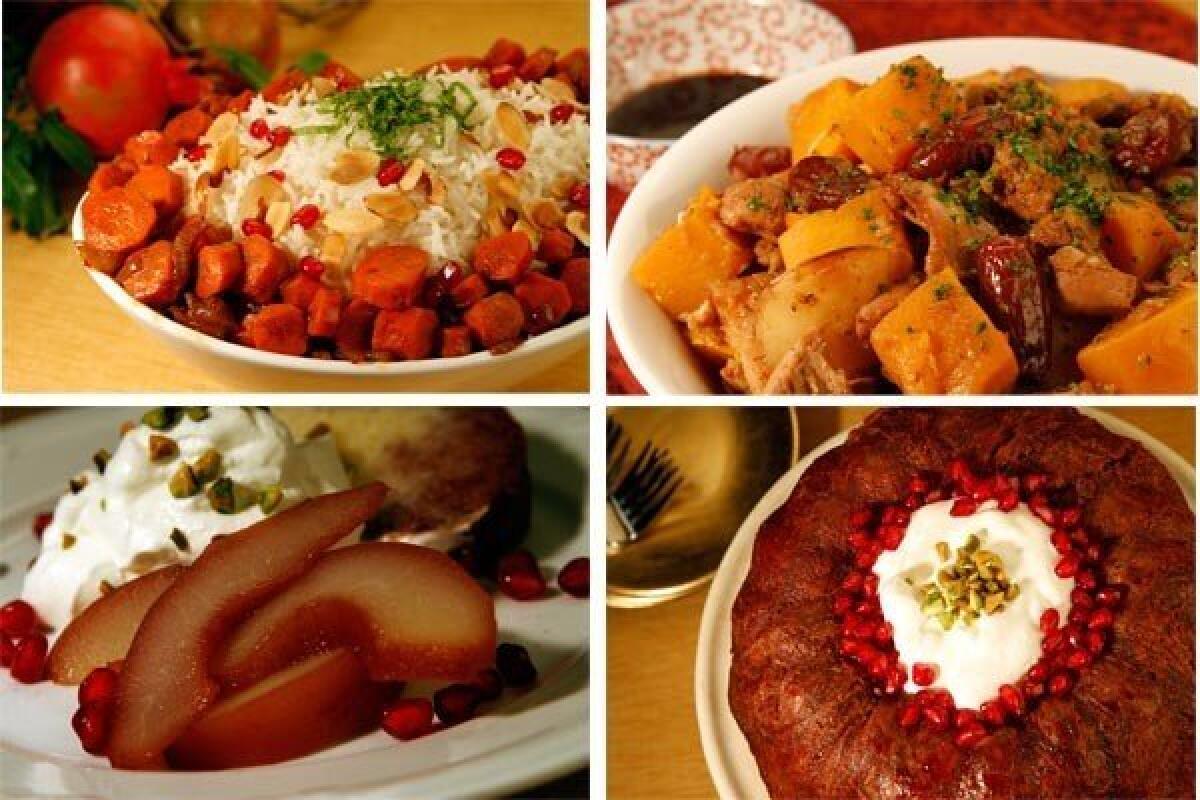Rosh Hashanah dishes are richer with pomegranate, date flavorings

- Share via
Pomegranates and dates, signature Rosh Hashanah fruits in many households, have been associated with the culture of the Holy Land since biblical times.
Both fruits made the Torah’s list of the Seven Species; the honey in that list is believed to have been date honey. Dates and date palm fronds play an important role in the region’s religious rituals. Pomegranates received the high honor of gracing the top of the Torah; pomegranate-shaped ornaments called rimonim, the Hebrew word for the fruit, crown the scrolls’ rollers.
Cooks in the Bible lands have developed concentrated flavorings from pomegranates and dates, and our Rosh Hashanah dishes benefit from these fruit essences.
Pomegranate molasses is also known as pomegranate paste or pomegranate concentrate. It is made by cooking the fruit’s juice until it is very thick. The intensely flavored paste is used in dressings, marinades and stews and is drizzled over grilled meat at the table. Because pomegranate molasses has a dark color, dressings made with it are best added to salads at serving time.
For more delicate dressings, use the sweet-tart juice of the pomegranate. This juice can also be used like red wine, for example, for poaching pears, which gain a lovely hue from the reddish-purple poaching syrup.
Date molasses, which can be found at Middle Eastern and kosher markets, contributes a mellower flavor to sauces than sugar or honey. In home kitchens it is made by mashing cooked or soaked pitted dates, squeezing the juice from the date pulp in a cloth, and simmering the juice until it becomes syrupy.
Cooks use date molasses in dishes as varied as roast chicken and noodle kugel, or mix it with pure tahini to make a breakfast dip for bread. For dessert, date molasses can be used like honey or maple syrup and drizzled over yogurt, ice cream, plain cakes or pancakes.
Brands of date molasses, pomegranate molasses and pomegranate juice differ in flavor depending on the fruit variety used and whether sugar has been added. When you cook with these products, taste to adjust the sweetness of the dish.
For our Rosh Hashanah tzimmes, the traditional stew made with sweet vegetables and dried fruit, we sweeten the sauce with date molasses, also called date honey, date syrup or silan, and we substitute dates for the customary prunes.
Or consider a new take on sweet carrot coins, a common accompaniment on many Jewish New Year tables. Instead of cooking the carrots in water with sugar, we roast them with pomegranate molasses and honey to give them a deeper color and a richer, more complex flavor. We use the glazed carrots as well as pomegranate arils to garnish our rice pilaf with almonds and fruit, a Sephardi Rosh Hashanah favorite.
It’s just a slight twist, but it finds the essence of these traditional holiday ingredients and dishes.
More to Read
Eat your way across L.A.
Get our weekly Tasting Notes newsletter for reviews, news and more.
You may occasionally receive promotional content from the Los Angeles Times.









